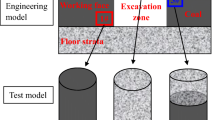Summary
A large scalein situ compression test of a laminated coal cube is described. The cube was uniformly loaded by a system of hydraulic jacks supplied simultaneously from one pump. At the same time both load and deformations were controlled. Deformations were measured by 60 longitudinal gauges located at the side surface of the cube in the regular net. Due to the heterogeneity of the rock the readings showed scatter. As a first approximation, the scattered data were fitted to the plane using the least square method. Orientations of the planes were analysed and show permanent relative movement between adjacent lamina indicating complex behaviour of the cube under loading. Detailed analysis of this behaviour indicated that the cube was subjected to both bending and twisting.
Similar content being viewed by others
References
Bieniawski, Z.T. (1968) The effect of specimen size on the compressive strength of coal,International Journal of Rock Mechanics and Mining Sciences 5, 325–35.
Bieniawski, Z.T. and Van Heedren, W.L. (1975) The significance ofin situ tests on large rock specimens,International Journal of Rock Mechanics and Mining Sciences, Geomechanical Abstracts 12, 101–14.
Cyrul, T. (1983) Notes on stress determination in heterogeneous rocks, inProceedings of the International Symposium of Field Measurement in Geomechanics, Zurich.
Cyrul, T. (1984a) A large scalein situ compression test on a 1.5 m coal cube, inProceedings of the Second International Conference on Stability in Underground Mining, University of Kentucky, Lexington, USA.
Cyrul, T. (1984b) Study of the scale effect in coal. Unpublished report.
Gimm, W.A.R., Richter, E. and Rosetz, G.P. (1966) A study of the deformation and strength properties of rocks by block testsin situ in iron ore mines.Proceedings of the First Congress of the International Society of Rock Mechanics, Vol. 1, 457–63. Lisbon, Portugal.
Gustkiewicz, J. (1975a) Strain fluctuations in heterogeneous rocks,International Journal of Rock Mechanics and Mining Sciences, Geomechanical Abstracts,12, 181–9.
Gustkiewicz, J. (1975b) Uniaxial compression testing of brittle rock specimens with special consideration of the effect of bending moment,International Journal of Rock Mechanics and Mineral Sciences, Geomechanical Abstracts,12, 13–25.
Hawkes, I. and Mellor, M. (1970) Uniaxial testing in rock mechanics laboratories,Engineering Geology,4, 177–285.
Lama, R.D. (1970)In situ and laboratory strength of coal.Proceedings of the 12th U.S. Symposium on Rock Mechanics, Rolla, Missouri, USA.
Lama, R.D. and Vutukuri, V.S. (1978)Handbook on Mechanical Properties of Rocks, Vol. III Trans Tech Publications.
Peng, S. and Johnson, A.M. (1972) Crack growth and fracture of Chelmsford granite,International Journal of Rock Mechanics and Mining Sciences,9, 37–86.
Seely, F.B. and Smith, J.O. (1962)Advanced Mechanics of Materials, John Wiley and Sons, Inc.
Timoshenko, S. (1955)Strength of Materials, D. Van Nostrand Company, 3rd edn.
Wawersik, W.R. and Brace, W.V. (1971) Post-failure behaviour of a granite and diabase,Rock Mechanics,3, 61–85.
Author information
Authors and Affiliations
Rights and permissions
About this article
Cite this article
Cyrul, T. Complex behaviour of a coal sample in a large scalein situ compression test. International Journal of Mining and Geological Engineering 4, 257–271 (1986). https://doi.org/10.1007/BF01552956
Received:
Issue Date:
DOI: https://doi.org/10.1007/BF01552956




